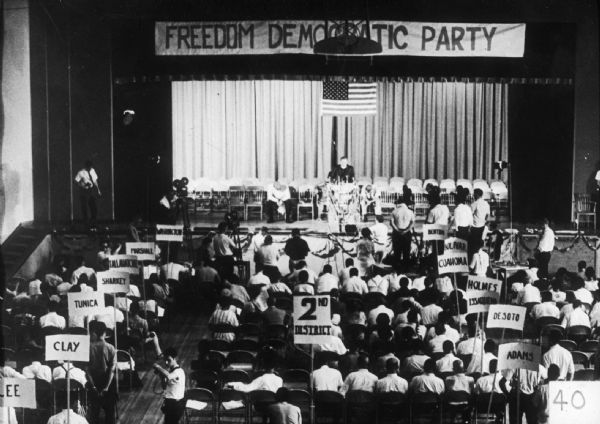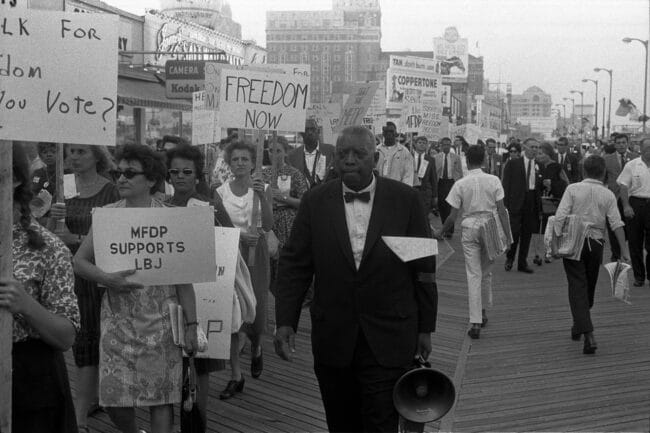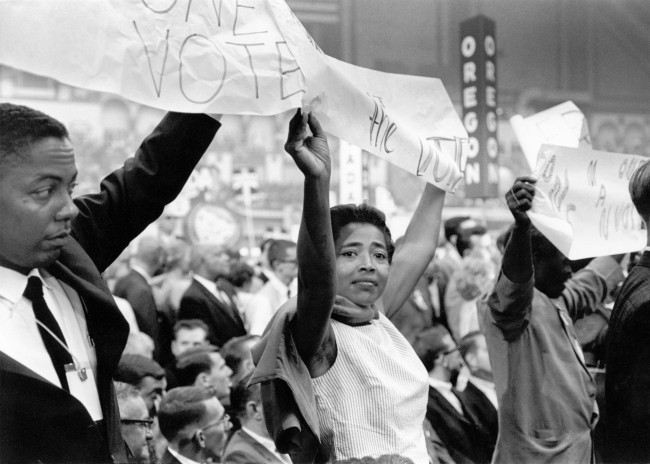
Freedom Democratic Party State Convention in Jackson, Mississippi on August 6, 1964. Photographer unknown.
This lesson explores one of the most important events in the fight for true democracy in U.S. history, when a coalition of grassroots activists challenged the Mississippi political system, the federal government and the national Democratic Party that excluded citizens on the basis of race.
Working within the political “rules,” the activists formed the Mississippi Freedom Democratic Party (MFDP or FDP) in 1964 and mounted a legitimate challenge to the existing system of race-based exclusion. In the process, they garnered a national audience and sparked moral and ethical debates.

African American and white Mississippi Freedom Democratic Party supporters holding signs reading “Freedom now” and “MFDP supports LBJ” while marching on the boardwalk at the 1964 Democratic National Convention, Atlantic City, New Jersey. Source: Library of Congress, Public domain
As historian John Dittmer explains in Local People: The Struggle for Civil Rights in Mississippi:
The Freedom Democratic Party (FDP) was one of the most important and distinctive institutions to emerge from the civil rights movement. It challenged white supremacy in the most repressive state in the South, combining grassroots activism with a radical social agenda. FDP had its origins in the fall of 1963, when the Council of Federated Organizations (COFO) conducted a “Freedom Vote” to dramatize the exclusion of African Americans from the political process in Mississippi.
More than 80,000 blacks voted black NAACP state president Aaron Henry for governor and white Tougaloo College chaplain Ed King for lieutenant governor in this mock election. The election’s success led to the creation of an independent, black-led, state Democratic Party that would challenge the legitimacy of the state’s white supremacist delegation at the Democratic National Convention in Atlantic City, New Jersey, in the summer of 1964.
The events surrounding the MFDP’s efforts to be seated at the Democratic National Convention of 1964 in Atlantic City provide a strong example of the unprecedented and sophisticated organizing techniques used to challenge the state sponsored terrorism that blocked voting rights based on race.

MFDP delegates demonstrate as President Lyndon Johnson is being nominated, Atlantic City, New Jersey, 1964. Victoria Gray from Hattiesburg, the woman at center, is a prominent MFDP leader. Image: George Ballis/TakeStock.
In this lesson, students step into the shoes of key people at the Democratic National Convention in a dramatic role play based on the real challenges and decisions facing the MFDP delegates.
It is our hope that after this introduction to the MFDP, students will want to learn more about the people and the strategies used to fight for voting rights in the United States.
Download lesson at civilrightsteaching.org.
Save













Twitter
Google plus
LinkedIn